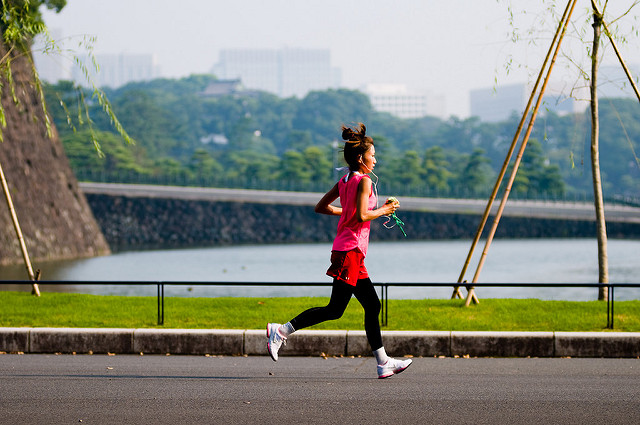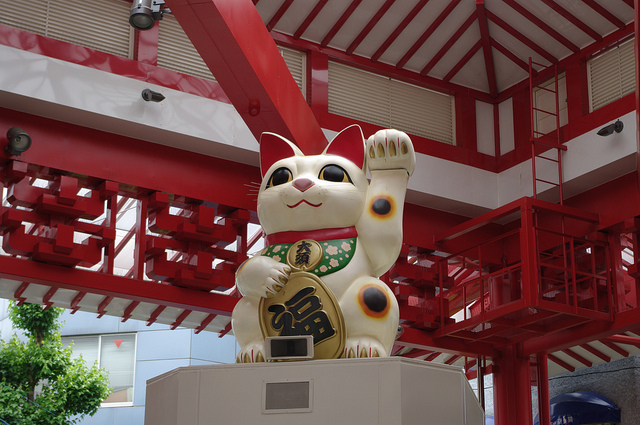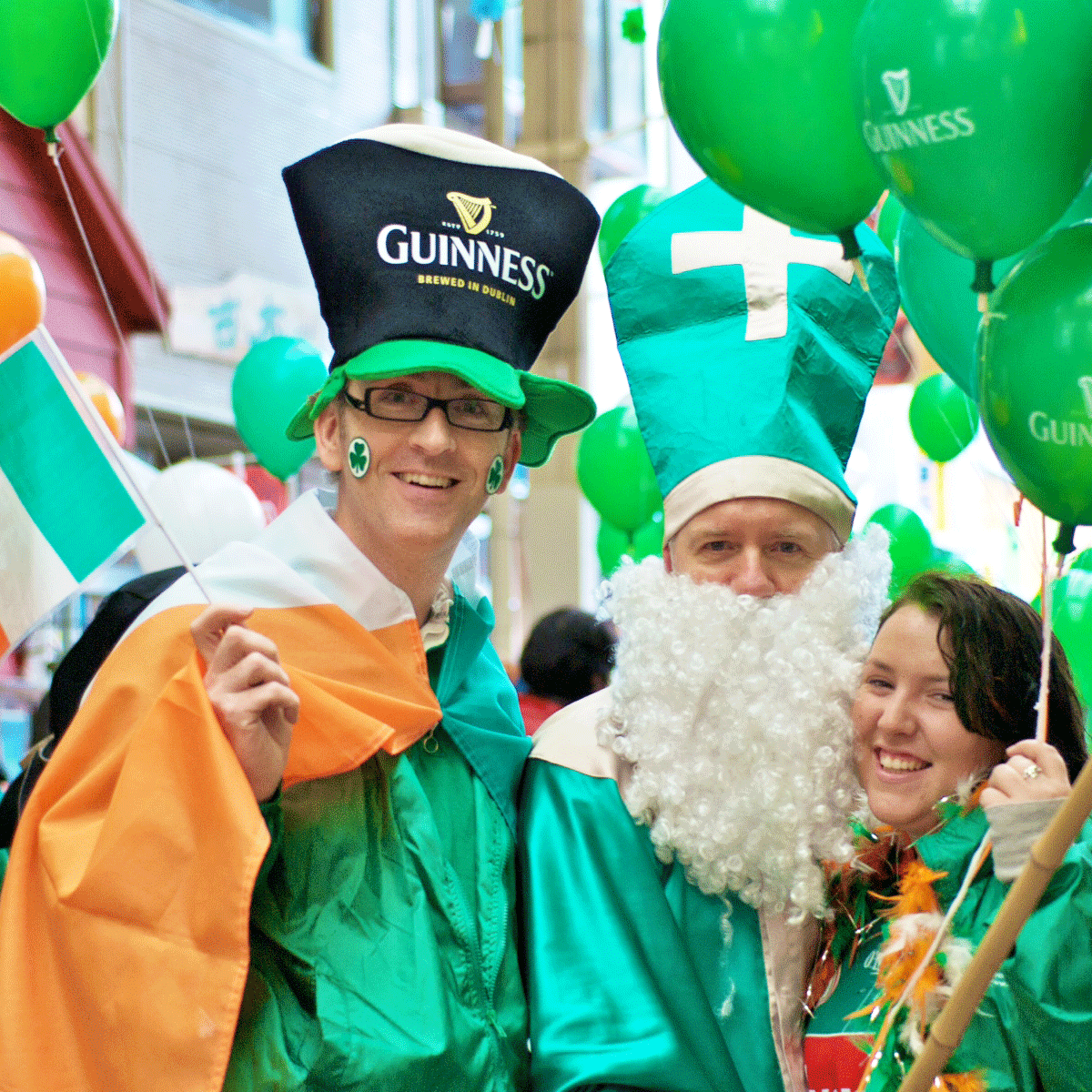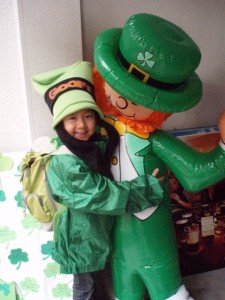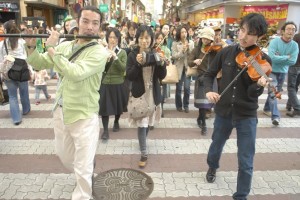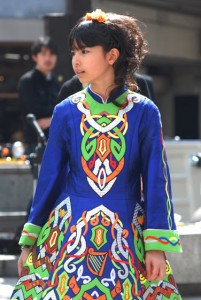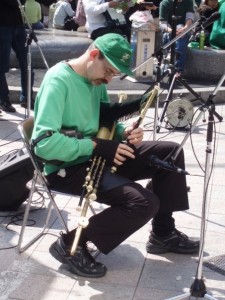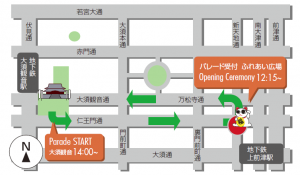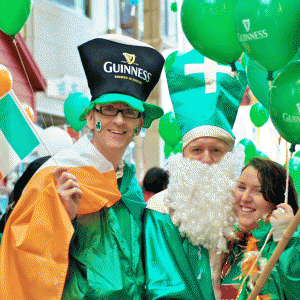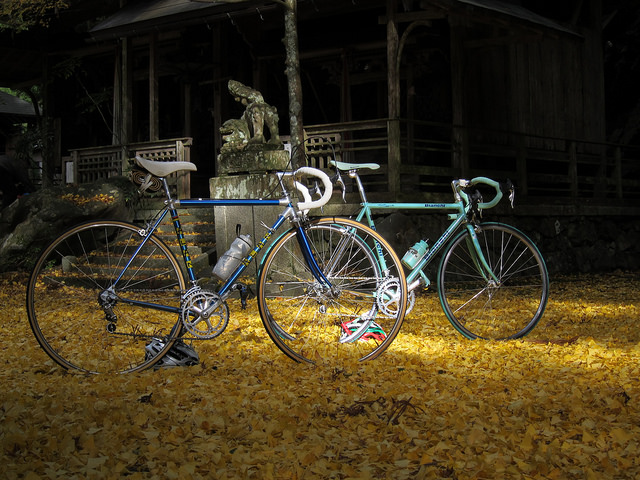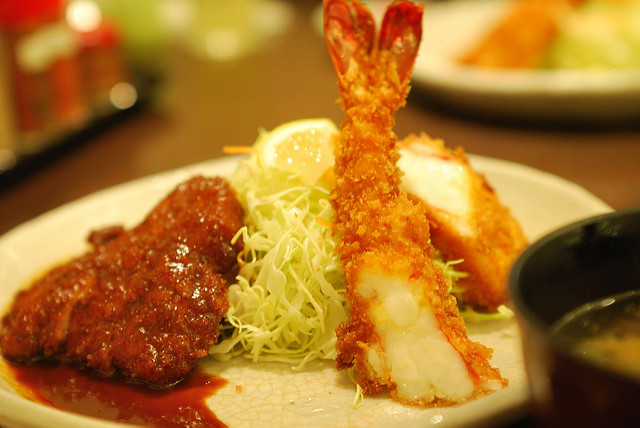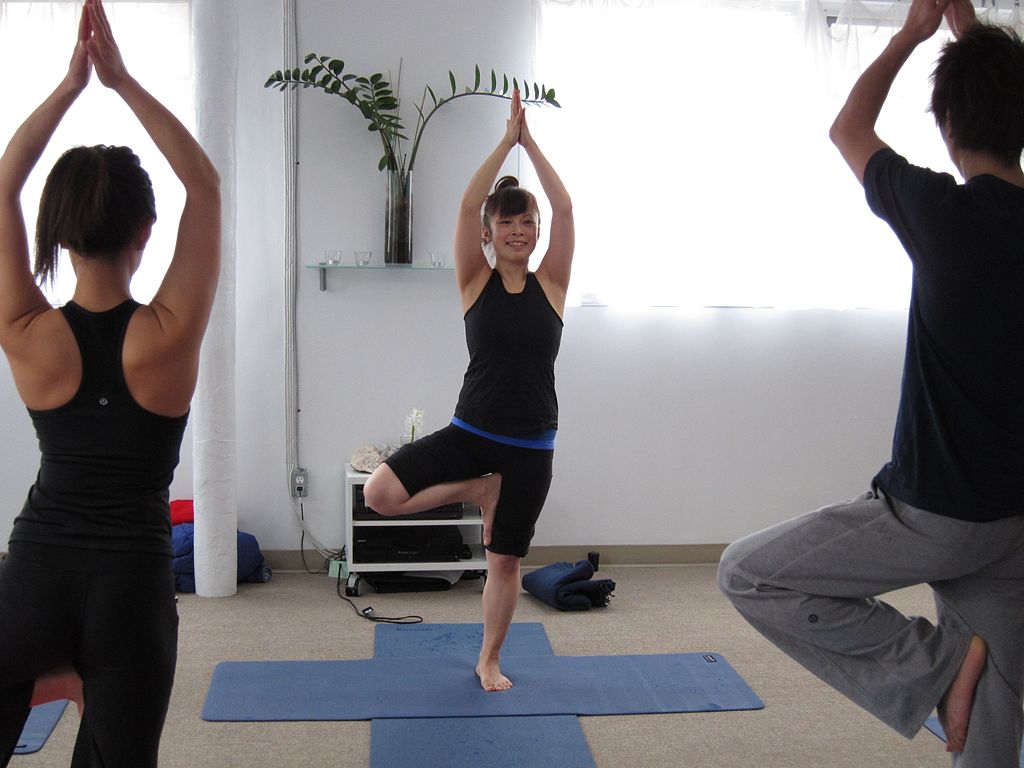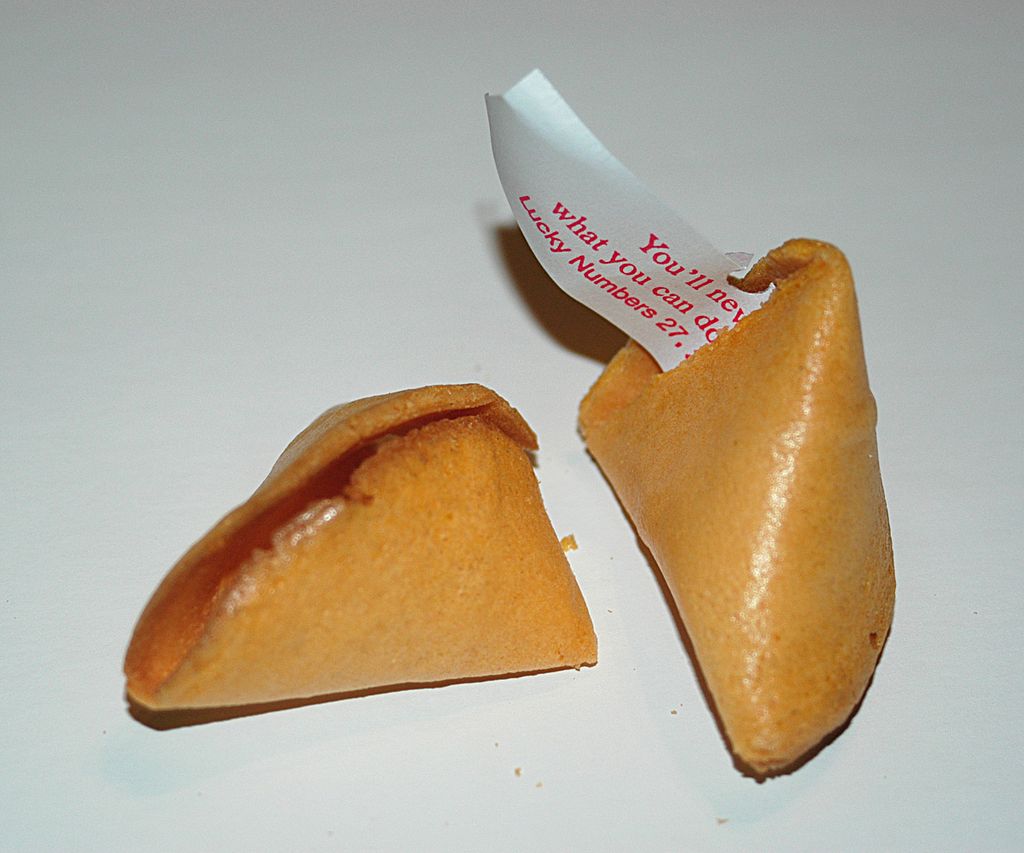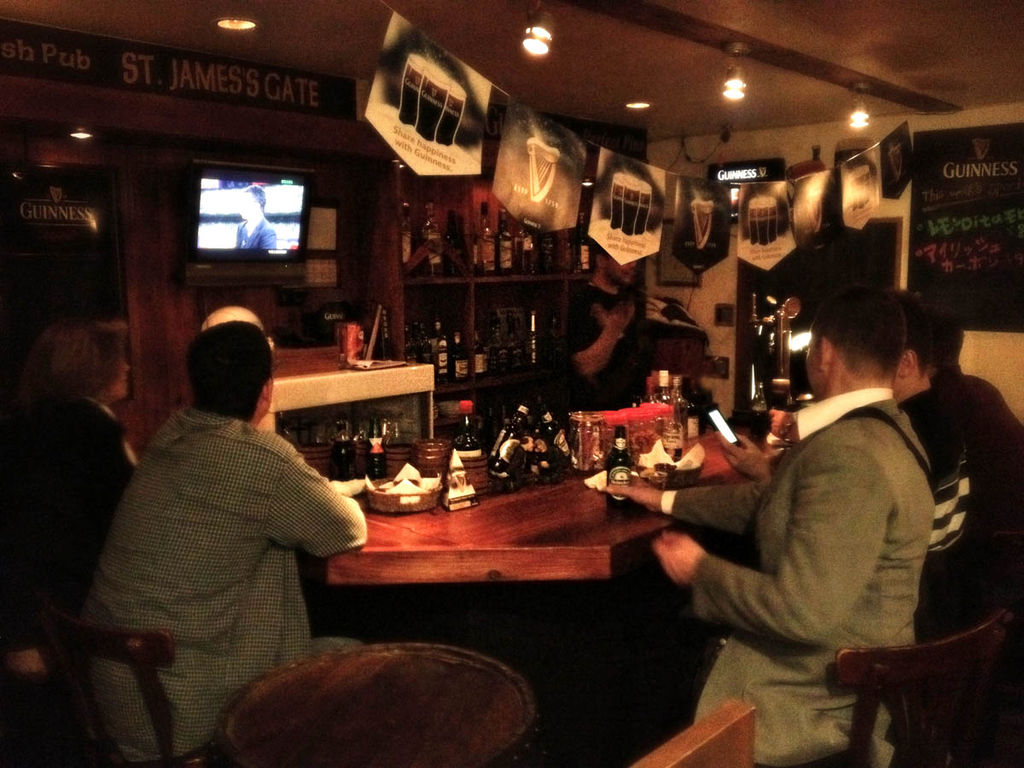Feb 27, 2017
Getting fit – The Best Places to Run in Tokyo

If like me you have gained a few extra pounds over the winter – Christmas and the various new year festivities will do that to you – you may be thinking of the coming summer months and wanting to get back into shape. There are plenty of ways you can do this. You could head to one of the city’s excellent public swimming pools, you could join a gym, but if you are more of an outdoorsy type, maybe you would prefer to go for a run.
Of course Tokyo is very much a concrete city, but there are still some lovely places at which you can go jogging. Here are a few ideas for places at which to stretch your legs and shift those extra pounds.
Yoyogi Park
If you like a spot of people watching as you run then Yoyogi park is a great place to start. While on weekends it can be pretty busy, particularly in the summer months with picnickers, aside from the no-running area surrounding Meiji Shrine, there is plenty of room to jog freely on the ground’s spacious, green lawns. On top of that, the large, leafy trees offer a decent amount of shade from the hot sun. It’s easy to get to, and open 24 hours, meaning you can work up a sweat, no matter the time of year, and there are shower facilities should you want to head out into Harajuku after your workout.
[googlemaps https://www.google.com/maps/embed?pb=!1m18!1m12!1m3!1d3241.2138520574376!2d139.6927560152586!3d35.67173598019646!2m3!1f0!2f0!3f0!3m2!1i1024!2i768!4f13.1!3m3!1m2!1s0x60188cb479620a33%3A0x34bcc78ce7f8bf3e!2sYoyogi+Park!5e0!3m2!1sen!2sjp!4v1487139835876&w=650&h=200]
Imperial Palace
The Imperial Palace is a great place to run for those just starting out. It has a 5km loop and the route is well marked, so you can easily track your time and distance. Like Yoyogi park there are facilities such as lockers and changing spaces surrounding the area, but it is pretty open to the elements, which makes it pretty hard going in the summer. Still, it’s a pretty beautiful place to run.
[googlemaps https://www.google.com/maps/embed?pb=!1m18!1m12!1m3!1d3240.66786490062!2d139.75061081493234!3d35.685179337363515!2m3!1f0!2f0!3f0!3m2!1i1024!2i768!4f13.1!3m3!1m2!1s0x60188c0d02d8064d%3A0xd11a5f0b379e6db7!2sImperial+Palace!5e0!3m2!1sen!2sjp!4v1487140069869&w=650&h=200]
Meguro River
There is little more relaxing for the mind than running alongside a river. This four kilometer-long route winds through the city making it a great course for inner-city runners, particularly in the springtime when the cherry blossoms are in full bloom. However, be careful not to get too relaxed and run head first into a group of hanami-spotters!
[googlemaps https://www.google.com/maps/embed?pb=!1m18!1m12!1m3!1d3242.1264584241567!2d139.68512716812666!3d35.649255867250446!2m3!1f0!2f0!3f0!3m2!1i1024!2i768!4f13.1!3m3!1m2!1s0x0%3A0x62a5e4632ba38cc4!2sMeguro+Sakura!5e0!3m2!1sen!2sjp!4v1487140400626&w=650&h=200]
Arakawa
For experienced runners, Arakawa is the site of the Arakawa Marathon in March, meaning you can go on and on and on, should you so wish. It is described as being ‘pancake flat’ and there are few obstacles other than fellow runners and the odd cyclist. For those wanting to challenge themselves for distance, this is a run for you.
[googlemaps https://www.google.com/maps/embed?pb=!1m18!1m12!1m3!1d3239.372374852944!2d139.51569371525974!3d35.717059480185945!2m3!1f0!2f0!3f0!3m2!1i1024!2i768!4f13.1!3m3!1m2!1s0x6018e5f2ce0fb48f%3A0x26c80b3e809bb2!2sKoganei+Park!5e0!3m2!1sen!2sus!4v1487745430298&w=650&h=200]
Tamagawa River
Another lengthy run along a river, the Tamagawa stretch has a whopping 48km to its name. The scenery is stunning and as there are no cars, you can fully enjoy the wide open spaces and admire the river. Another advantage is that there are plenty of train stations along the route, meaning that should you over stretch on the distance, you can easily get back home.
[googlemaps https://www.google.com/maps/embed?pb=!1m18!1m12!1m3!1d12983.02024205056!2d139.69185828476168!3d35.559751033562975!2m3!1f0!2f0!3f0!3m2!1i1024!2i768!4f13.1!3m3!1m2!1s0x6018607017bf3a07%3A0x524b7a21e17553a6!2z44CSMTQ2LTAwOTUg5p2x5Lqs6YO95aSn55Sw5Yy65aSa5pGp5bed!5e0!3m2!1sja!2sjp!4v1487745568017&w=650&h=200]
Mt. Kumotori Ascent
Now this route is a bit on the hardcore side. Okay, more than a bit. Mt. Kumotori is Tokyo’s tallest peak at a height of 2,017 meters and is most frequently populated by mountaineers and animals such as deer, wild boar, monkeys and, possibly bears. However it has become popular for runners wanting to get right off the beaten track. Those who think they can take it are recommended to stay the night along the trail to really get the most out of the experience, oh and to travel in a group, because should you get injured, it’s a long hobble back to the car. Should you feel you’ve got what it takes, easiest access is from Omatsuri, at the intersection of Tokyo, Saitama, and Yamanashi Prefectures.
[googlemaps https://www.google.com/maps/embed?pb=!1m18!1m12!1m3!1d3233.7397317155096!2d138.94180281526354!3d35.85538498015396!2m3!1f0!2f0!3f0!3m2!1i1024!2i768!4f13.1!3m3!1m2!1s0x60194cb7173d961d%3A0x7078a18244f514d0!2sMount+Kumotori!5e0!3m2!1sen!2sus!4v1487745649749&w=650&h=200]
By Mark Guthrie
Image by Justin C. (Own work) [CC BY-SA 2.0], via flickr.com (modified)
Feb 27, 2017
Set Out for Hiroshima’s Best Morning Sets!

If you’re anything like me, breakfast during the week is a hurried affair and usually involves coffee and something quick and easy to eat. On the weekends though when I can relax, I like to head out and about to find breakfast places or coffee shops that specialise in what the Japanese refer to as morning sets or モーニングセット. This usually involves coffee, a boiled egg, thickly sliced, buttered toast (sometimes with the option of jam) and a small salad.
Since the start of this year I’ve made it my aim to go to one new place every weekend. Although the menu doesn’t vary much from place to place, the ambience alone is enough to keep seeking out both well-known and popular haunts, and those in the back streets that are some of Hiroshima’s best kept secrets.
If you’re a little nervous about walking into the more traditional, old-style Japanese coffee shops, why not dip your toes in at qone of the chains. I don’t mean Tully’s or Doutor, I’m talking about Kohiken.
Kohikan
Kohikan has an English menu and although the branch in Hondori is centrally positioned, it’s basement location is quiet and cozy. It opens at 7am every single day of the week and at that time on a weekend you are often lucky enough to have the whole place to yourself.
The morning set here includes among a number of choices, the option of scrambled eggs with a dash of tomato sauce or a poached egg. If you prefer just toast and a boiled egg that’s also available. Best of all, you only pay an extra 160 yen or 80 yen (in the case of toast and a boiled egg) on top of your choice of coffee which starts at 400 yen.
Kohikan
〒730-0035 Hiroshima-ken, Hiroshima-shi, Naka-ku, Hondōri, 7−25 (map link)
082-247-0225
7:00-23:00 (Monday to Sunday)
www.kohikan.jp
Buruumaunten
Moving up the ladder of confidence, next on the list is ブルーマウンテン (Buruumaunten). This gem is on the second floor of a building that wouldn’t look out of place in England or Europe. The furnishings include red velvet chairs and lace curtains and the chandelier adds a touch of romance to this enchanting hideaway. Handmade menus can be found on the tables with photos included so even if you don’t speak or read Japanese you can point to which breakfast you want to order.
I chose the full morning set and I watched TV and heard my crispy toast being bought it I could have been sitting in the kitchen at my moms house in Australia. For 600 yen I would easily pay the little bit extra again to experience the peace and quiet and the familiar sounds which made me feel so at home. The ma and pa who own it are also lovely and were thrilled to receive a foreign visitor.
Buruumaunten
〒730-0035 Hiroshima-ken, Hiroshima-shi, Naka-ku, Hondōri, 3−17 (map link)
7:30-11:00 (breakfast available)
082-247-5764
Burajiru
The third place I recommend is a little further off the beaten track and means a trip to an older part of town. The Takanobashi Arcade has a rundown feel to it and ぶらじる(Burajiru) or Brazil in English, has been there for decades churning out their morning sets.
With no English menus, this is the very place to test your katakana reading skills. They usually have two morning sets on offer and the staff will even bring over a selection of spreads for you to choose for your toast. I highly recommend the strawberry jam option.
The place is spacious and harks back to the romantic age of the early 30s and 40s. As one of the first places to serve morning sets in Hiroshima, it is definitely a place to include and tick off on your Hiroshima bucket list.
There are many, many more places to discover in Hiroshima, but make sure to visit these three for a taste of class and freshly buttered toast.
Burajiru
〒730-0051 Hiroshima-ken, Hiroshima-shi, Naka-ku, Ōtemachi, 5 Chome−6 (map link)
080-244-2327
7:00-20:00 (Monday-Saturday)
7:00-18:00 (Sunday)
Image by I, 小太刀 [GFDL, CC-BY-SA-3.0 or CC BY-SA 2.5-2.0-1.0], via Wikimedia Commons
Feb 26, 2017
Getting to know you: Osu, Nagoya
Between Nagoya’s central transport area of Meieki (Nagoya Station) in the west, and the lively shopping and commerce hub of Sakae in the east lies Osu, one of the city’s more interesting and eclectic areas. Centered around its covered shopping arcade, Osu has an atmosphere similar to Tokyo’s Harajuku, with aging hippies happily rubbing shoulders with teenage Goth Lolita cosplayers; though without quite so much of the self-referential pretension of it’s capital city counterpart.
A Spot of Culture – Ōsu Kannon
 When getting off at the Ōsu Kannon subway station on the Tsuramai line, it is difficult to miss the large Buddhist temple from which the station takes its name. The original temple was built in 1333, though to save it from regular flooding the shogun Tokugawa Ieyasu had it moved from where it had stood in Ōsu-gō, Nagaoka village, (now known as Hashima in Gifu Prefecture) to its position today. Unfortunately this did not protect it from the devastation it suffered following a large fire in the 1820s. It was rebuilt 150 years later, which is what we can see today, but this does not detract anything from its beauty.
When getting off at the Ōsu Kannon subway station on the Tsuramai line, it is difficult to miss the large Buddhist temple from which the station takes its name. The original temple was built in 1333, though to save it from regular flooding the shogun Tokugawa Ieyasu had it moved from where it had stood in Ōsu-gō, Nagaoka village, (now known as Hashima in Gifu Prefecture) to its position today. Unfortunately this did not protect it from the devastation it suffered following a large fire in the 1820s. It was rebuilt 150 years later, which is what we can see today, but this does not detract anything from its beauty.
- Address: 21-47 Osu 2-Chome, Naka-ku, Nagoya
Shopping – Osu Shopping District
 Aside from the temple, the other thing that sticks out is the Osu Shopping district. It has stood for around 400 years and currently has something in the region of 1200 stores ranging from kimono shops that have stood for generations to brand new electronics stores selling top of the range goods. As well as retaining something of a traditional working class atmosphere with greengrocer markets and butchers it is also home to some of the city’s more outlandish fashion outlets, making it a place for both Nagoya’s teenagers and septuagenarians to come for their shopping needs.
Aside from the temple, the other thing that sticks out is the Osu Shopping district. It has stood for around 400 years and currently has something in the region of 1200 stores ranging from kimono shops that have stood for generations to brand new electronics stores selling top of the range goods. As well as retaining something of a traditional working class atmosphere with greengrocer markets and butchers it is also home to some of the city’s more outlandish fashion outlets, making it a place for both Nagoya’s teenagers and septuagenarians to come for their shopping needs.
- Address: Banshoji-Dori, Osu 3-chome, Naka-ku, Nagoya
- Website: www.inbound.nagoya-osu.com
Street Eats – Osu
 Perhaps due to the fact that eating whilst walking is frowned upon (if you are walking you are not showing enough respect to what you are eating), in Japan you don’t see much street food compared to other Asian countries. Osu is very much the exception to this rule. Every where you look there are stalls selling a variety of food stuffs, mostly along the same lines as the summer festival ‘yatai’ food, all of which are perfect for mid-shopping snacking in these cold summer months. Particularly popular is Tako Saka (たこ咲) a small shack selling the perfect takoyaki. Highly recommended.
Perhaps due to the fact that eating whilst walking is frowned upon (if you are walking you are not showing enough respect to what you are eating), in Japan you don’t see much street food compared to other Asian countries. Osu is very much the exception to this rule. Every where you look there are stalls selling a variety of food stuffs, mostly along the same lines as the summer festival ‘yatai’ food, all of which are perfect for mid-shopping snacking in these cold summer months. Particularly popular is Tako Saka (たこ咲) a small shack selling the perfect takoyaki. Highly recommended.
- Address: Banshoji-Dori, Osu 3-chome, Naka-ku, Nagoya
- Website: www.inbound.nagoya-osu.com
International dining – Solo Pizza
 If you want something to eat whilst eating, there are also plenty of international options. You will more than likely be hallooed at by the guys in the kebab shop, you can get excellent burgers in Wood’s Diner, drink coffee and smoke shisha in cafe Kemuri and it takes a person of strong reserve to walk past Brazilian restaurant Ossu Brazil without the smell of the rotisserie chicken drawing them in. But for true international dining excellence head to Solo Pizza. As winners of a major Pizza Championship in Naples, it is without hyperbole, amongst the best pizza in the world.
If you want something to eat whilst eating, there are also plenty of international options. You will more than likely be hallooed at by the guys in the kebab shop, you can get excellent burgers in Wood’s Diner, drink coffee and smoke shisha in cafe Kemuri and it takes a person of strong reserve to walk past Brazilian restaurant Ossu Brazil without the smell of the rotisserie chicken drawing them in. But for true international dining excellence head to Solo Pizza. As winners of a major Pizza Championship in Naples, it is without hyperbole, amongst the best pizza in the world.
- Address: 3 Chome-32-8 Sakae, Naka Ward, Nagoya
- Website: www.solopizza.jp
Expat Bar – Smash Head
 There aren’t so many expat bars in Osu, but without wishing to damn it with faint praise, Smash Head is by a long way the best that the area has to offer. At one time it was a motorcycle mechanics-cum-cafe, but it has since forgone the grease monkey to focus on the much tastier grease element. Smash Head serves up a wide array of great burgers, as well as doing a pretty decent pint of Guinness, making it a meeting spot for much of Nagoya’s Irish contingent on the day of the area’s Paddy’s Day Parade.
There aren’t so many expat bars in Osu, but without wishing to damn it with faint praise, Smash Head is by a long way the best that the area has to offer. At one time it was a motorcycle mechanics-cum-cafe, but it has since forgone the grease monkey to focus on the much tastier grease element. Smash Head serves up a wide array of great burgers, as well as doing a pretty decent pint of Guinness, making it a meeting spot for much of Nagoya’s Irish contingent on the day of the area’s Paddy’s Day Parade.
- Address: 2 Chome-21-90 Osu, Naka Ward, Nagoya
- Website: www.smashhead.main.jp
Events – Antique Market (Ennichi)
 While the area of Osu is always buzzing with people, this is particularly the case during one of the many events that are held there. The most regular is the flea market held rain or shine on the 18th and 28th of every month, at which you can find in the mishmash of genuine antiques and complete junk, fine art and kitsch. Other annual events include the St Patrick’s Day Parade, the Cosplay Summit and the Osu Summer Street Performers’ Festival. In February it is also the location of one of Nagoya’s biggest Setsubun events.
While the area of Osu is always buzzing with people, this is particularly the case during one of the many events that are held there. The most regular is the flea market held rain or shine on the 18th and 28th of every month, at which you can find in the mishmash of genuine antiques and complete junk, fine art and kitsch. Other annual events include the St Patrick’s Day Parade, the Cosplay Summit and the Osu Summer Street Performers’ Festival. In February it is also the location of one of Nagoya’s biggest Setsubun events.
- Address: 21-47 Osu 2-Chome, Naka-ku, Nagoya
- Website: www.inbound.nagoya-osu.com
Mark Guthrie
Main image: flickr.com “Lucky Cat” by Tiffany Key (CC BY-SA 2.0) -Modified
Image: flickr.com “R0019076” by Gen (CC BY-SA 2.0) -Modified
Image: flickr.com “Banshoji-Dori, Osu 3-chome, Nagoya” by kinpi3 (CC BY-SA 2.0) -Modified
Image: flickr.com “Takoyaki“ by Frédéric BISSON (CC BY-NC-SA 2.0) – Modified
Image: www.solopizza.jp -Modified
Image: www.blaineanderin.com -Modified
Image: flickr.com “Flea Market in the Temple Complex“ by Vanny (CC BY-NC-SA 2.0) – Modified
Feb 25, 2017
St. Patrick’s Day Parade in Nagoya 2017!

The Osu Shopping Arcade will be bopping to an Irish jig as throngs of people in green descend to partake in this year’s annual Nagoya St. Patrick’s Day Festival! With live music, Irish dancing, official parade, local characters, face painting, hair painting, body painting, free giveaways, and much much more the NAGOYA ST.PATRICK’S DAY PARADE in Osu is the place to be in March. Wear some green and come by with the family, your friends, animals, leprechauns, invisible friends, and whoever else will fit, and join us as we celebrate!.
From the official event description
Dia duit and Cead Mile Failte to everyone!
(or how to celebrate St Pat’s day in Nagoya)
Here’s a great big shout out to all ye Nagoyites, green and not so green, to let you know that the Nagoya St Patrick’s Day Festival is rolling around once again! That’s right, it’s time to dust off your green garb, give ’em the lovin’ lick of an iron and bring yourself, your family, your loved ones and even your not-so-loved ones down to Osu in Nagoya to partake in Nagoya’s best (and only) Irish event of the year!
The fun begins with live Irish music and dance session that the Nagoya Irish Tribune hails as a “must see” and “one of the top ten most wondrous sights in the world” (without a whiff of cultural bias). There will be 25 pairs of legs leaping about to the tunes of a gaggle of Irish musicians underneath the Maneki Neko (Welcome Cat) in Osu Kannon shopping area. The craic (atmosphere, for the rest of you) is guaranteed to be, er, craicing?
After that tasty appetizer, you’ll be force-fed more greens of the Irish variety as you wind on down to the street adjacent to Osu Kannon Temple. At 14:00 the 11th Nagoya St Patrick’s Day Parade will commence. If you hadn’t already had your fill, there will be loads more music, pipers, face painting, freebies, Irish dogs, …and, and, and!! Word has it that Ambassador to Ireland Anne Barrington will be in attendance to help Nagoya celebrate the 100th Anniversary of the Easter Rising: When in 1916 a small band of Irish Republicans declared a free Irish State and set the path toward Irish independence.
After all that high-kickin’ Irish jigging and parading about, you’ll have surely developed a thirst for more things Irish. Luckily for you, the post party drinks will be plentiful in the sponsoring bars. There’ll be a wide selection of Irish delights including music, more dancing and the ubiquitous Guinness… and even Kilkenny… on special!
So scribble the date in your green diary, put on your dancing boots and get yourself down to Osu Kannon from midday, and celebrate what it means to be truly Irish, or British, or Australian, or Canadian, or Japanese, or American, or from whatever lovely country you were born…. Don your green and let the Irish celebrate you!
If you or your group are interested in volunteering, please contact inj-nagoya(at)inj.or.jp Volunteers are needed for the big day – if you are green, keen, or both, please check out www.inj.or.jp/group/inj-nagoya for complete information. All are welcome to participate, and it’s a truly fun experience!
See you tthere!
NAGOYA ST.PATRICK’S DAY PARADE 2017
From 12:00, Sunday, March 19th 2017
Venue Osu Kannon, Osu Shopping Streets (Osu Kannon Temple, Naka Ward, Nagoya City) Google Map
Schedule
12:00〜 Opening Ceremony at Maneki Neko Square
14:00〜 Parade Start from the public road “Nioumon-dori” in front of Osu Kannon Temple※1
15:30〜 Family Event at Park(Shirakawa Kouen Park)
To get to Osu Kannon you can use the Nagoya City Subway system. The nearest subway stations are
- Kamimaezu, on the Tsurumai and Meijyo subway lines, or
- Osu Kannon on the Tsurumai subway line.
There is limited public parking, and public transportation is strongly encouraged.
This is a really fun, and welcoming event so come with your family and have some fun!
Feb 24, 2017
Irish Pubs in Nagoya

Pub Arco
Without wanting to lean on lazy stereotypes, there is something about the Irish and drinking. Wherever I have been in the world, whether it be Gothenburg or Kathmandu, I have stumbled across an Irish bar. Nagoya is no different, and with St. Patrick’s Day coming up, it’s a good time to check one or two (or, if you can manage it, all) of them out. Here are just a few that you can head to in order to celebrate all things Ireland.
Pub Arco – Meieki
I briefly mentioned Pub Arco in last month’s post about where to spend Valentine’s Day in Nagoya, and in that post I said that it is my favorite pub in Japan. Owner Yoshi-san spent quite a bit of time in the Emerald Isle and the dark wood decor, his great English ability and the emphasis placed on sitting at the bar to chat with other locals reflects this. This isn’t the most raucous of pubs in town, but it is the best place to enjoy a beer or one of his many, many different whiskeys. For this year’s St Patrick’s Day festivities both Jameson’s and Guinness will be on discount. And if you see me in there propping up the bar, which is more than likely, please say ‘hi’!
- Where: 2 Chome-20-30 Meieki, Nishi Ward (map)
- Contact: 052-784-6488
- Website: www.www.facebook.com/PubArco
Peat Irish Tavern – Meieki
Peat Irish Tavern, behind the Meieki Hub, is just about as ‘Oirish’ as it gets, and as well as the soft tinkling of diddlee-dee music playing overhead, there is more Irish paraphernalia on the walls than you can shake a shillelagh at. Seating options are between an open dining area replete with the heavy, gnarled wooden furniture you would expect of the Emerald Isle, or you can plonk yourself in one of the comfy armchairs in the snug, bringing to mind quiet nights of sipping whiskey with old friends.
- Where: 1F Nagoya Daiya Bldg. #2, 3-15-1 Meieki, Nakamura-ku (map)
- Contact: 052-589-3767
- Website: www.lightdining.co.jp/restaurants/peat-irish-tavern
The Curragh – Sakae
The Curragh is another lovely little Irish bar, nestled away out of sight. Named after an area of Ireland that us renowned for breeding race horses, pub owner and racing enthusiast Teri-san is as welcoming a host as you could wish to find, and while their fish and chips is the best I have found in Japan, there is also a great mix of beers: from Brew Dog craft beers to Guinness and even Magners’ Irish Cider on draft. If you are looking for dark and late, The Curragh is underground and open until 4am. This year for St Patrick’s Day there will be live performances on March 19. Contact the bar for more details.
- Where: 3 Chome-16-8 Sakae, Naka Ward (map)
- Contact: 052-249-4884
- Website: www.the-curragh-irishpub.com
Shamrock – Fushimi
I first stumbled across Shamrock in Fushimi back in my earliest days of being in Nagoya, lost, trying to find my friends in the nearby Hub. That night I never bothered finding my friends and just stayed in Shamrock chatting to the staff, having a whale of a time. Shamrock is still a good craic, and put on occasional events, including performances by local Irish troubadour legend Brian Cullen. If you want the full experience, try their Irish dinner course of Irish soda bread, fish and chips, Irish mussels in white wine, cottage pie, cold cut meat and others for just 2,500 JPY. Throughout the St. Patrick’s Day weekend you can get a Guinness or a Kilkenny for 700 JPY, and there will be live Irish music performances on the 17th from 19:00 and the 19th from 17:00.
- Where: Naka Ward, Sakae, 1 Chome−5−14, Momotato Building B1
- Contact: 052-201-2050
- Website: www.shamrock-irishpub.com
Coat of Arms – Fushimi
While not strictly an Irish bar, as a Commonwealth pub, and having a harp in their eponymous coat of arms I suppose it just squeaks in under the wire. Which is a good thing too, because CoA is a pretty decent bar, something of a hangout for the JIS and More Than Relo crews. If you are after the Irishness, they have Kilkenny Irish Cream on tap, and in the week leading up to St. Patrick’s Day they will be celebrating their 4th anniversary so there will be loads of events coming up including a party on March 10 with 3,000 JPY unlimited all you can eat and drink. Then, from the 14th to the 19th Jameson’s is just 500 JPY and Shepherds Pie will be on special.
- Where: 2-6-12 Nishiki,Naka-ku (map)
- Contact: 052-228-6155
- Website: www.coatofarms.jp
Coopers – Meieki
Some of you may be considering heading over to Coopers in Meieki for St. Patrick’s Day, but don’t. Not because it isn’t a great pub, but simply that it closed down recently, which is a shame because it was my first local pub in Nagoya. So this is just a public service announcement, and a recommendation that you try the other places above instead.

Slánte mhath!
By Mark Guthrie
Image by https://www.bar-and-restaurant.com/photos/S10737/large1.jpg (modified)
Image by David Duran (Own work) [CC BY-SA 2.0], via flickr.com (modified)
Feb 24, 2017
Nagoya’s Best Bicycle Shops
Nagoya, with its wide roads and ample cycle paths, is a marvelous city to cycle around, so it is such a shame that so many people choose to clog up the sidewalks with their ‘mamachari’ bicycles. According to the Japanese National Police Agency, there were 71.551 million bicycles in Japan in 2013 but most people tend to ride what even my dear old mother would call ‘old lady bikes’.
But if you know where to look, you can find some great bike shops around the city that sell all sorts of specialized cycles, including road bikes, mountain bikes, commuters or even BMXs. So, what are you waiting for? Get off the sidewalks and start really enjoying this wonderful city and its beautiful surroundings!
Kato Cycle
Family owned with a great selection and friendly (English-speaking) staff, Kato Cycle is perhaps the most popular cycle shop in the city for road bikes, mountain bikes and apparel.
- Where: 2 Chome-8-26 Kakeage, Minami-ku (map)
- Contact: 052-811-3741
- Website: www.katocycle.com
Circles
Circles is a really cool bike shop, if a little on the pricey side. They have tonnes of apparel and accessories too, as well as offering a repair service. The guys in there are a really decent bunch and speak, or at least understand, a little English too.
- Where: 4-14-20, Chiyoda, Naka-ku (map)
- Contact: 052-331-3232
- Website: www.circles-jp.com
Y’s Road
For convenience, Y’s Road in the centre of Sakae is pretty useful. With claims to be the largest store for road bikes in Nagoya, you can probably find what you want, particularly if what you want is Canondale. I was in there this month (Feb 2017) and the staff couldn’t have been more helpful.
- Where:Naka Ward, Nishiki, 2−2−13 Nagoya Center Building (map)
- Contact: 052-220-3977
- Website: www.ysroad.co.jp/nagoya
Fukui
Whether for accessories, parts or complete bikes, Fukui is a well known pro-bike shop. I haven’t been there myself, but it comes highly recommended by those in the know and stocks many of the popular brands to suit most budgets.
- Where: Nakagawa-ku Maedamachi 41 (map)
- Contact: 052-361-0123
- Website: www.fukui-c.co.jp
Fun Bikes Kaze
Don’t let the name fool you, Fun Bikes Kaze is not a bike shop for kids. Based out in Nagakute, they stock everything from beginner cycles to the pro end of the spectrum. As well as supplying parts and operating repairs, they also organize cycling trips out into the local area.
- Where: Nagakute-shi Yamagoe 114 (map)
- Contact: 0561-61-5326
- Website: www.fb-kaze.com
Jinrikisha
Jinrikisha (meaning ‘rickshaw’) is a little further afield, out in Seto, but if you have the time to get out there, it’s worth the trip. Recommended by one of the more prominent cyclists in the area, apparently the owner is considered to be one of the best cycle mechanics in Japan. Unfortunately he doesn’t speak English, but he does know French.
- Where: Seto-shi, Aichi Prefecture To Terayama-machi 35 (map)
- Contact: 0561-85-7615
- Website: www.jinrikisha.com
Cycling Clubs
If you are keen on getting out on your bike, there are a couple of cycling groups in the area. Check out Nagoya Cycling Club, Cycling Nagoya or Nagoya Cycling Friends.
Mark Guthrie
Image by jun.skywalker (enishi hand made cyclecap) (Own work) [CC BY-SA 2.0], via flickr.com (modified)
Feb 24, 2017
Nagoya Cuisine and Where to Get it
While many of the more famous or popular Japanese dishes come from the Kanto or Kansai regions, that doesn’t mean that Nagoya doesn’t have some amazing food to discover. Nagoya food (Nagoya meshi) is a hugely varied and diverse cuisine, encompassing the traditional ‘washoku’ as well as the more modern ‘yōshoku’.
Below is an introduction to some of Nagoya’s best dishes and the best places to pick it up.
Miso Katsu
While white miso is favored throughout most of the country, Nagoyans are immensely proud of their red ‘hatcho’ miso sauce. Cut a Nagoyan and he shall bleed it, and then, more than likely he will find a tonkatsu fried pork cutlet on which to pour the rich sweet and savory sauce as to not to waste a sacred drop. When out-of-towners think of Nagoya meshi, it is miso katsu that they think of.
You can get miso katsu in izakayas all over the city, but by far and away the most famous restaurant is Yabaton. Established more than 60 years ago, Yabaton is a Nagoyan institution, which is evidenced by the queues that stretch right down the street from its Yaba-cho branch at peak times. But that should not dissuade you from trying it out, because it is in their Wariji Tonkatsu that the taste of Nagoya lies.
- Best restaurant: Yabaton
- Where: All over the city, but the Yaba-cho Honten branch is the original. 3-6-18 Naka-ku, Osu (map)
- Website: www.english.yabaton.com
Tebasaki
Tebasaki, or fried chicken wings is, alongside miso katsu, possibly the ‘daddy’ of Nagoyan cuisine. There are two really famous tebasaki chains that serve Nagoya. The older of the two is Furaibo, which spices its chicken wings in the traditional Nagoya way. However, if you like a bit of spice in your life, there is a much more peppery version available at Sekai no Yama-chan, which has so many branches of its shop in the Kanayama area, that if one of their shops is full the waitress can literally walk you to another just around the corner.
- Best restaurants: Furaibo, Sekai no Yama-chan.
- Where: All over the city, see websites for details
- Website: www.furaibou.com www.yamachan.co.jp
Ebi Furai
Developed at the turn of the 20th century as a reaction to the growing popularity of other Meiji era yoshoku, Ebi Furai, or deep fried breaded prawn, is enjoyed all over the country. No matter where you go in Japan, you can probably find ebi furai on an Izakaya menu or in a bento box.
Ebi furai can be best found in two particular forms: preposterously long (30cm!) or in a hearty sandwich. The former can be found in Nagoya’s most famous ebi furai restaurant, Maruha. Whilst you can find branches of this seafood orientated izakaya elsewhere in Nagoya, it is the views of the city and the airy atmosphere of the Sakae branch that makes it stand out. If you want something a bit simpler, the ebi furai sand (fried prawn sandwich) is the way to go, and while many restaurants do them, none can compare to Konparu. These somewhat rough and ready cafes are dotted around the city, but my favorite one is near the entrance to the Higashiyama line in Nagoya Station.
- Best restaurants: Maruha, Konparu
- Where: La Chic 8F, Sakae 3-6-1, Nakamura-ku (map); Meichika, 3丁目-14-15 Meieki, Nakamura-ku (map)
- Website: www.lachic.jp www.konparu.co.jp
Doteni
Doteni is another dish that, like miso katsu, incorporates the red hatchi miso that Nagoyans love. Its English name of ‘offal stew’ does little service to this red miso stew that is perfect for warming cold bodies on chilly winter nights. There can be various ingredients in doteni, but generally it consists of beef tendon simmered for hours in the miso broth. In some small restaurants you might find a large doteni bowl on the counter with beef skewers poking out for you to help yourself. That’s when you know you’ve found a good place.
Opened in 1949, Doteyaki Shimasho is a long-established Nagoya restaurant. At Shimasho the sauce looks so dark you’d expect it to be overpowering, but it actually has a surprisingly light and fresh flavor. The must-try dish is the assorted doteyaki plate, which includes beef tendon, egg, and daikon radish that has been prepared for ten whole days so that the flavors seep through. It’s highly recommended that you include a deep fried kushikatsu skewer or two as a side dish.
- Best restaurant: Doteyaki Shimasho
- Where: 2 Chome-1-19 Sakae, Naka Ward (map)
- Website: www.shimasho.biz
Ankake Spaghetti
No list of Nagoyan cuisine can be complete without ankake pasta. Which is kind of a shame because, well, it’s not exactly wonderful, particularly for diners who are used to Italian pasta dishes.
In Ankake Spaghetti, thick spaghetti noodles are pan-fried and topped with rich spicy sauce that is sticky like sauces you might find in Chinese restaurants. It is said to have originated during attempts to adapt a meat sauce or Bolognese to the taste of Nagoya people. Weiner sausages, onions, and green peppers are popular ingredients, and makes it a bright, almost lurid dish that looks like it could have been created for easily distracted children.
In spite of the criticism leveled at it (mainly by me, it has to be said), ankake spaghetti continues to be popular. It is said to have originated at Spaghetti House Sole in Sakae, but today the most popular restaurants are Spaghetti House Yokoi and Spaghetti House Ciao, the latter of which having been around since before the phrase ‘ankake spaghetti’ was even coined.
- Best restaurants: Spaghetti House Yokoi or Spaghetti House Ciao.
- Where: 1F Asahi building 3-14-25 Nishiki, Naka-ku (map); 1F Dai 5 Horiuchi Building 4-5-19 meieki, Nakamura-ku (map)
- Website: www.yokoi-anspa.jp www.ciao-morita.co.jp
Hitsumabushi
Strictly speaking hitsumabushi, or grilled eel, probably has closer ties to Tokyo or Osaka. But let’s forget that for a moment, because Nagoya does it so well that it has made it its own.
Hitsumabushi is kind of like an unagi donburi, or eel rice bowl, dish, but the way it is eaten is a bit different than a standard donburi meal. Hitsumabushi is served in a large bowl of rice topped with finely chopped unagi, with several other toppings and condiments. Generally, these will include green onions, dried seaweed, wasabi, and grated leeks, and a container of dashi, or fish stock soup. In addition to this, the setting will include pickled vegetables, and an empty bowl and rice scoop.
If you want the best hitsumabushi in town you are going to end up in Hōraiken. There are a couple of branches, but the one near Atsuta shrine is the coolest, with a more traditional feel. But be warned, there are no reservations and they get busy, so be prepared to wait outside for a while.
- Best restaurants: Hōraiken
- Where: 503 Gōdo, Atsuta-ku (map)
- Website: www.houraiken.com
Mark Guthrie
Image by fukumi (Own work) [CC BY-SA 2.0], via flickr.com (modified)
Image by kimishowota (Own work) [CC BY-SA 2.0], via flickr.com (modified)
Image by Yu Morita (Own work) [CC BY-SA 2.0], via flickr.com (modified)
Image by Rick Cogley (Own work) [CC BY-SA 2.0], via flickr.com (modified)
Feb 21, 2017
English Speaking Yoga Studios in Osaka

If you’ve been in Osaka for some time, you’re probably familiar with the many different gyms and fitness centers scattered throughout the city. For anyone looking for a place to work out, the most approachable options are likely the brightly lit, cardio machine-filled gyms that tend to take over entire floors of office buildings. However, if going to the gym isn’t your favorite way to exercise, there are many awesome group fitness options out there for you to get involved in. It can be intimidating to walk up to a studio offering classes, especially if you’re unsure if they have instructors that speak English. Luckily, for anyone interested in taking yoga classes for their fitness fix, the Kansai area has a few awesome options for yoga classes with English-speaking teachers!
Here is some information about noteworthy yoga studios around Osaka for you to check out. There are many more options than finding a gym to stay active, and the meditative, strengthening, and balancing art of yoga might be just right for you.
Spirit Yoga Studio
Since 2007, Spirit Yoga has been offering diverse and fun yoga classes with a variety of instruction styles. With an average of 24 classes per week, including Hatha, Vinyasa Flow, Power Yoga, Ayurveda, Pre-natal, and even kids classes, there is sure to be a class style to suit your skill level. The prices here are reasonable, and the studio is often offering special discounts so make sure to check their website before you arrive for the latest details. Classes here are taught by a mix of international staff and Japanese staff, so there are many English classes to choose from!
Where: Tenjinbashi Matsumura Bld. 5/6F, 3-10-17, Tenjinbashi, Kita Ward, Osaka 530-0041
Pricing:
3-trial lessons: 3,230 yen + 7,560 yen admission fee
Drop-in class: 2,700 yen
4 lessons in one month: 9,050 yen
Website: spirityogastudio.com
Tel: 06-6881-3317
Pure Yoga Kansai
This is a dynamic studio that offers classes taught in both English and Japanese spoken at the same time. Enjoy classes in Yin, Hatha, Vinyasa, and Nidra, designed for skill levels ranging from beginner to expert. In addition to classes, this studio often hosts different events and workshops centered around healing and balance, so be sure to bookmark their website to stay up to date!
Where: The studio Espace is a 1-minute walk from Tenjinbashisuji 6 Chome subway station, and a 10-minute walk from JR Tenma station, 13-15 Kanei-cho, Kita Ward, Osaka
Pricing:
1-time trial lesson: 1,000 yen
7 lesson pass: 10,000 yen
Website: http://www.pureyogajp.com/
Yoga Lotus Temmabashi
The staff at Yoga Lotus not only know yoga, but they also know customer service! The instructors here are very helpful and strive to help you have as enjoyable an experience practicing yoga as possible. Not all classes are taught in English, but they post the schedule of classes each week online so you can find one that fits your ability and language before you arrive! Classes here are much cheaper than other studios, and they do not require that participants purchase a membership with them so you can feel free to check things out before you commit.
Where: 5-minute walk from Temmabashi station, Horikawa Bldg 4F, 2-18 Kitahama-Higashi Chuo Ward, Osaka 540-0031
Pricing: *cash only*
1-time trial lesson: 2,000 yen
2-time trial lessons: 3,000 yen
Drop-in class: 2,500 yen
Website: http://yogalotus.namaste.jp/en/
Tel: 050-5873-0736
Photo by GoToVan (https://www.flickr.com/photos/gotovan/4440274580/) [CC BY 2.0], via Wikimedia Commons
Feb 21, 2017
So Why Isn’t It the Japanese Fortune Cookie?

The Chinese fortune cookie is one odd little pastry. Start with the fact that it is not a thing in China; that the Chinese do not serve fortune cookies after meals. Most of the three billion fortune cookies broken up each year are consumed in Chinese restaurants in the United States. Then throw into the fortune cookie’s convoluted existence that it was invented not in China or America but in Japan.
Like many traditions, the origin of the fortune cookie is a shade murky. The Chinese have celebrated special occasions for many hundreds of years by passing around Moon Cakes crafted from Lotus Nut Paste and when the country was occupied by Mongols in the 13th century these cakes would often contain subversive messages. That seems like quite a leap to the practice of delivering small wafer-like deserts with happy prophecies inside them to diners in the West but that is the Chinese claim to invention.
Making the Japanese case for the fortune cookie
A more tangible claim to Japanese creation comes from a discovery made in a family bakery near a Kyoto shrine in the 1990s. It was an old hand-made cracker shaped much like a modern fortune cookie and inside was an actual “omikuji,” or fortune slip. Further research by Yasuko Nakamachi, who spent six years digging into the Japanese roots of the fortune cookie while at Kanagawa University in Tokyo, uncovered an image of a man crafting fortune cookies in the Kyoto bakery in 1878. The batter is poured into molds and paper is folded into the confection while the emerging cracker is still toasty warm.
The family used 23 fortunes in its cookies and baked the treats for three generations before abandoning the practice when too many people were found to be devouring the goodies without knowing there was paper inside. How the fortune cookie then appeared in Chinese restaurants in America in less clear. It was always assumed, naturally, that the first wave of Chinese immigration to the United States in the 1860s to work on West Coast railroads brought the cookies from home. That not being the case, the real truth is buried under layers of stories passed down through families.
It appears that a few Japanese bakeries churned out fortune cookies in Los Angeles in the early 1900s. Going back even further, to the 1890s, there is evidence that visitors to the Japanese Tea Garden in San Francisco enjoyed fortune cookies from a local bakery called Benkyodo. Whatever the real story, Chinese restauranteurs, well aware of the American love of desserts and seeking a simple capper to their own menus, usurped the fortune cookie and made it their own by the 1930s.
The Japanese role in the fortune cookie has receded from view. So too has China’s role. Most of the fortune cookies today, about four million every day, roll off the assembly line at Wonton Food’s Fortune Cookie Factory – in Queens, New York City. And they are no longer rolled by hand in the style of their Japanese forebearers. The fortune cookie baking process has been fully automated since the 1980s.
Photo by User Lorax on en.wikipedia [GFDL or CC-BY-SA-3.0], via Wikimedia Commons
Feb 21, 2017
Top 5 Irish Pubs in Tokyo

If you’re looking for some fun and festive ways to get into the spirit of St. Patrick’s Day this March, Tokyo’s got you covered! Don’t want to wait until the 17th to celebrate? Why not check out one of these Irish Pubs, where it can be St. Patrick’s Day all year long! We’ve rounded up five of the top authentic pubs around the city so you can add Irish drinks and dining dates to your calendar.
Dubliners’
If you’ve spent much time in Tokyo, you’ve likely come across a Dubliners’ pub or two. What started out as one great pub in Shinjuku, quickly became a chain of restaurant/bars throughout the city. Happy hour lasts all day until 7:00 p.m., so get there early to enjoy some awesome drink deals and cheap eats!
Where:
Shinjuku: 3 Chome-28-9 Shinjuku, Shinjuku Ward,Tokyo
Ikebukuro: San-gurou-Bill B1F, 1-10-8 Nishi-Ikebukuro, Toshima Ward, Tokyo
Askasaka: Sanno-Park-Tower B1F, 2-11-1 Nagata-cho, Chiyoda Ward, Tokyo
Shibuya: Dogenzaka Center-Bill 2F, 2-29-8 Dogenzaka, Shibuya Ward, Tokyo
Shinagawa: 2-16-3 Kounan, Minato Ward, Tokyo Shinagawa Grand Central Tower B1F
Website (English): http://www.dubliners.jp/en.html
The Shannons
Hanging out inside a dark and grungy pub might be more authentic, but sometimes a break for fresh air is just as nice! The Shannons has an awesome outdoor patio for you to enjoy some delicious fish and chips and happy hour drinks in the cool spring afternoon!
Where: Near Osaki station in the Gate City Osaki Complex
Tel: 03-5437-5779
Irish Pub & Restaurant Failte
If you’re looking for a more relaxed pub-like atmosphere, Restaurant Failte might be the perfect option for you! They have an impressive selection of bottled ales from all around the world, and some delicious pub food on the menu to match!
Where: Across from Shibuya station in the Shibuya Mark City Complex
Website (Japanese only): http://failte.jp/
An Solas
A favorite among Japanese, expats, and tourists alike, this authentic Irish watering hole is a bit hard to find, but once you do you’ll never forget it! Try one of their famous burgers, play some darts in the back, or have a chat with Will at the bar over a perfectly poured Guinness!
Where: 5 Chome−22−3 Sendagaya, Shibuya Ward, Tokyo 151-0051
Tel: 03-5919-6686
The World End
Located right across from Ueno station, The World End Irish Pub combines the slightly cramped style of small Japanese bars with the atmosphere and energy of a true Irish pub! If you stop in for a selection of their delicious brews, make sure to sign on a note of your home country’s currency so they can add it to their worldly collection!
Where: 6-14-7 Ueno, Taito Ward, Tokyo 110-0005
Tel: 03-3837-8870
Photo by JamesAlexanderJack [CC BY-SA 3.0], via Wikimedia Commons
